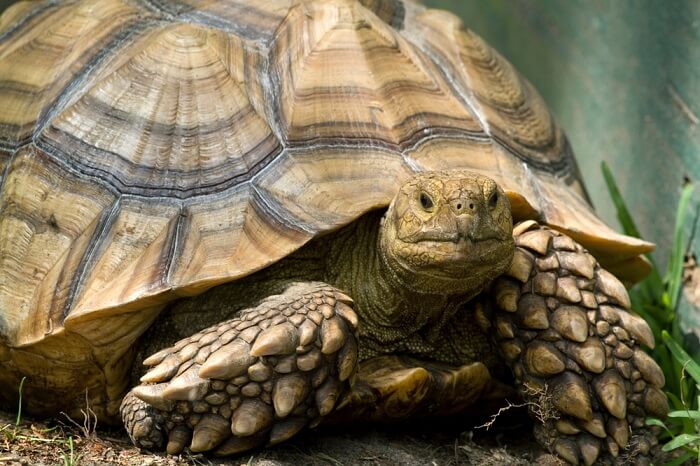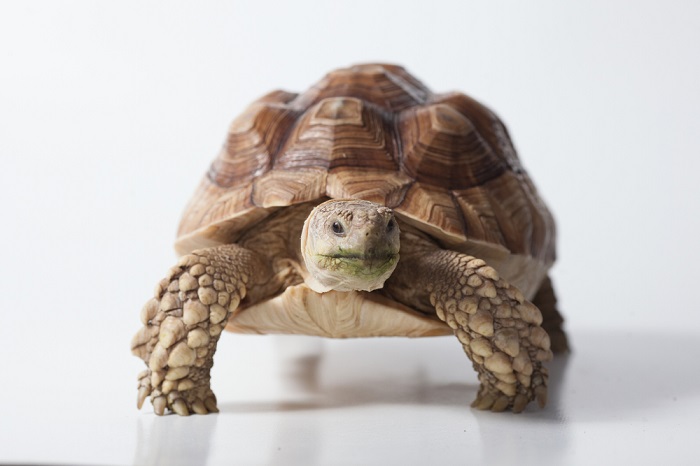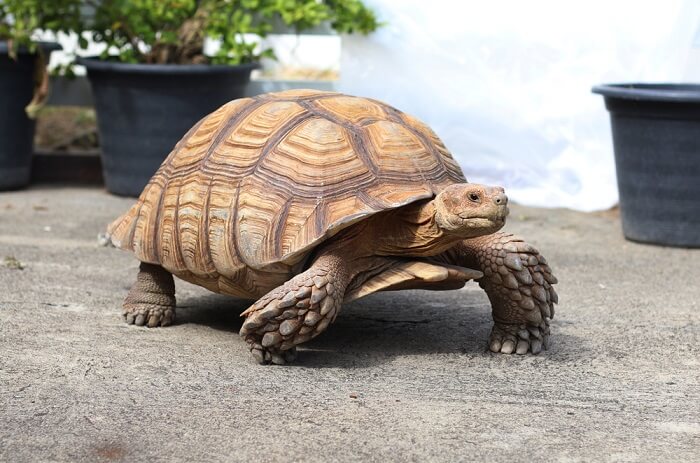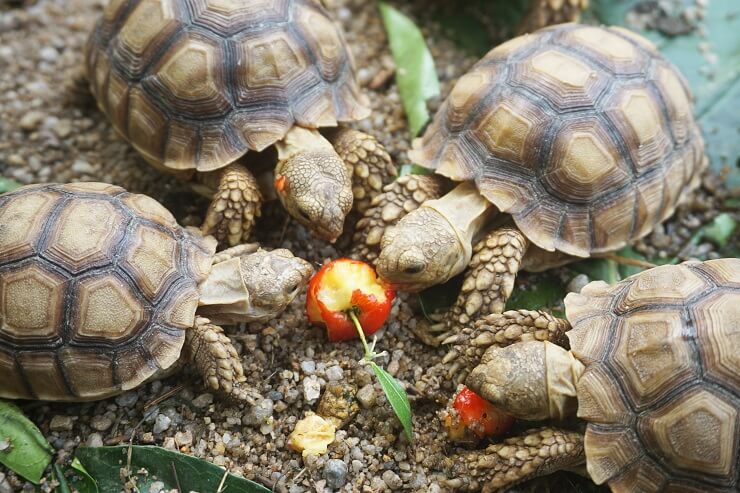Sulcata Tortoise As A Pet: Care, Temperament And Diet
This page contains affiliate links. We may earn money or products from the companies mentioned in this post through our independently chosen links, which earn us a commission. Learn More
Sulcata tortoises can make good pets, but they do have some specific needs in order to be healthy and happy. This article will help you understand those needs and decide if a sulcata tortoise is right for you.
Care
Care of a reptile includes providing the right enclosure. It needs the proper temperature, lighting, humidity, substrate and size. They also have a long lifespan, so you may need to plan ahead to pass them on to family.
Cage Size

Sulcata tortoises grow to be over 100 pounds and 2 feet in length. Keep that in mind for the long-term plans. While a 20-gallon aquarium may be fine for a juvenile, your adult tortoise will need a much larger enclosure.
Indoors a designated bedroom would be required. In the right climate, they can be kept outdoors in an enclosure.
The area should be 10 x 10 feet or larger. Outdoor enclosures will need a strong perimeter fence or wall that extends several feet below the surface to avoid escape. Outdoor enclosures also need to protect them from raccoons, dogs and other animals that may cause harm.
Substrate
Both indoor and outdoor enclosures should have a substrate that allows digging and burrowing behaviors. Most solis outdoors in yards will be fine. Indoors, several inches of sterile potting soil or coconut fiber are recommended in at least part of the enclosure.
Timothy hay can be used in other areas. The floor should be hard to destroy and easy to clean. Carpets should be removed and wood floors need to have a protective covering.
Temperature

Either indoor or outdoor enclosures need to have a temperature that stays above 75͒F at all times. They also require a heat source that provides a basking area of 90-95F. Indoors, a powerful heat lamp or ceramic heater can provide the needed heat source.
Make sure that the lamp is above the level that would allow direct contact, and for enclosures with multiple animals, provide several basking areas.
Outdoors, the sun can act as the heat source in the right climate. A shelter should be provided that allows protection from the heat and allows access to an area in the low 80sF. In cooler weather, the shelter should be heated to allow continued access to the preferred temperature range.
Lighting
Like most reptiles, sulcata tortoises need access to UVB lighting to make Vitamin D3 and utilize calcium properly. For outdoor tortoises, the sun provides the best source of UVB that can be found.
For indoor tortoises, a UV light must be provided for 12 hours a day. Sulcatas need a high-intensity UV light as natives to an equatorial climate. Be aware that the UV spectrum wanes long before the light burns out, so it should be replaced every 6 months.
Humidity

Sulcatas are native to arid grasslands in northern Africa. Although this is a very dry region, they burrow into the ground and have access to higher humidity on a regular basis. Excessively low humidity could also be a contributing factor to the pyramiding of the shell (abnormal growth patterns).
At least part of the enclosure should offer humidity of 45-55%. Indoors, use a hygrometer to make sure that the required humidity is provided. Outdoors, a deep burrow can provide what they need.
Temperament
Sulcata tortoises are very gentle despite their size. Your pet will likely be willing to eat from your hand and may follow you around in a yard. They’re very unlikely to bite unless you’re a vegetable.
That being said, they are large and strong. Combine that with a stubborn streak that’s common in the species, and they can be like having a bulldozer with a brain of its own. They can get through barriers that would be strong enough to contain most other animals.
They can also move heavy furniture in the house. You can try to redirect them, but the stubborn streak will have them turn around and try again, and again, and again. Keep this in mind when making the enclosure and deciding if your home is ready for a sulcata.
Diet

Sulcata tortoises are strict vegetarians. They should never be given foods designed for other animals. Dog and cat food has a good deal of animal protein that they can’t digest effectively. Animal protein is very hard on their kidneys and will lead to early kidney failure.
High fiber, low nutrient density foods should be the main portion of the diet. Timothy or orchard hay should be available at all times. For outdoor enclosures or yards, various grasses can be planted for grazing.
Bermuda, fescue and Kentucky Bluegrass, and clover are all safe for them to graze. Make sure that areas available for grazing are not treated with any weed killers, fertilizers, insecticides, or other chemicals.
In addition to the hay and grass for grazing, salads can be offered 4-6 times a week. Vegetables that are good for the salads include a base of Romaine lettuce, red-or-green leafed lettuce, or dandelion greens.
The occasional addition of collard greens, carrot tops, kale, and mustard greens are fine as long as they are done more as treats. You can add other vegetables for variety: carrots, cactus pads, cucumber, bell pepper, butternut squash (steamed) and bok choy seem to be favorites.
Rare treats of fruits can be offered for treats. They should be uncommon treats because the sugar content isn’t good for their digestion. When given, though, it can be a great deal of fun watching them attack strawberries, tomatoes or watermelon.
With a good UV source and the proper vegetables, supplements aren’t needed and excess calcium may be one of the things that contribute to the pyramiding of the shell. If your sulcata is a picky eater, then supplementing some calcium and vitamins weekly may be beneficial.
Water should be available in the enclosure and should be cleaned and replaced daily. In addition to the water bowl, they’ll love it if there’s a muddy area to rest in and cool themselves.
Health Concerns
Sulcata tortoises should be seen regularly by a veterinarian. The most common health concerns that you may see include:
- Respiratory infections
- Bladder stones
- Heat stress
- Trauma (animals)
- Ingestion of inappropriate objects
- Nutritional disease
- Shell damage
- Parasites
Summary
Sulcata tortoises have a great temperament and can be a great pet for someone willing to make the commitment to the care they require.
FAQs:
Are Sulcata tortoises good pets?
Sulcata tortoises aren’t for everyone. They require a good deal of care and a large enclosure size. They are also large and strong, and can be messy at times. However, they are some of the most unusual tortoises available as pets and if you have the space, they can be wonderful pets.
Are Sulcata tortoises illegal?
In the wild, they are critically endangered and it’s illegal to have a wild-caught sulcata tortoise. However, sulcata tortoises readily breed in captivity and are legal in most states. Some places require permits. Check the laws in your area before adopting a sulcata tortoise and make sure you get a captive-bred animal.
Are Sulcata tortoises easy to keep?
No, they are very challenging pets and require a large area to live in and very specific lighting and temperature. Make sure you’re ready for the responsibility, because they also live 100 years or more with good care.
How big do Sulcata tortoises get?
As adults they can be more than 2 feet long and weigh more than 100 pounds!
Can you let a tortoise roam the house?
That’s not advisable for several reasons. One, they can easily damage furniture due to their size and strength. For their safety, they need to be in an area that is safe. They are grazing animals, and in a home environment they may ingest things that aren’t safe. Finally, they need to have access to basking areas that are hot and have UV light access. That’s difficult to offer is they roam freely in a home.



